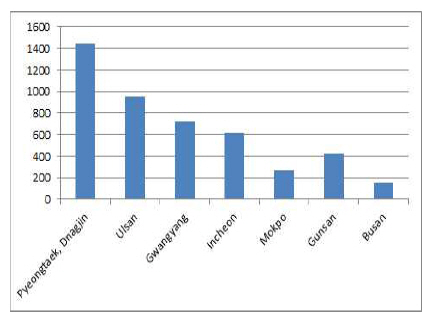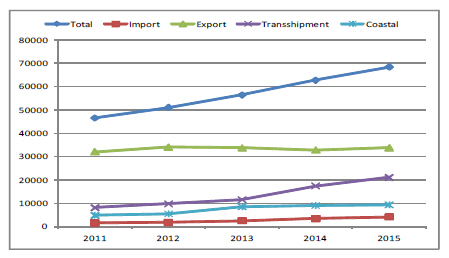1 Bang, H S, Kang, D J and Park, J H““A Study on the Efficiency Analysis of Major Container Ports””, Korea trade review, (2011), Vol. 36, No. 2, pp. 1-23.
2 Banker, R D, Charnes, A and Cooper, W W“ “Some models for estimating technical and scaleinefficiencies in data envelopment analysis””, Management science, (1984), Vol. 30, No. 9, pp. 1078-1092.

3 Beskovnik, B and Twrdy, E““Managing Maritime Automobile Terminals: An ApproachToward Decision-Support Model for Higher Productivity””, International Journal of NavalArchitecture and Ocean Engineering, (2011), Vol. 3, No. 4, pp. 233-241.

4 Brucato, J“Improving Car Port Terminals Efficiency Through Modelling and Simulation”, Proceedings of the International Conference on Harbor Maritime and Multimodal Logistics M&S 2013), pp 100-105.
5 Caves, D W, Christensen, L R and Diewert, W E““The economic theory of index numbers andthe measurement of input, output, and productivity””, Journal of the Econometric Society, (1982), pp. 1393-1414.

6 Charnes, A, Cooper, W W and Rhodes, E““Measuring the efficiency of decision making units””, European journal of operational research, (1978), Vol. 2, No. 6, pp. 429-444.

7 Cheon, S H, Dowall, D E and Song, D W““Evaluating impacts of institutional reforms on port efficiency changes: Ownership, corporate structure, andtotal factor productivity changes of world container ports””, Transportation Research Part E, (2010), Vol. 46, pp. 546-561.

8 Choi, K Y““A Research on the Factors for Selecting Pyeongtaek Port for Importation of Cars””, Journal of Korea Port Economic Association, (2011), pp. 231-245.
9 Fischer, T and & Gehring, H““Planning vehicle transhipment in a seaport automobile terminal using a multi-agent system””, European Journal of OperationalResearch, (2005), Vol. 166, No. 3, pp. 726-740.

10 Kim, H S, Sun, I S and An, S B““A Study on the Effect of Automobile Port"s Service Quality onCustomer Satisfaction and Loyalty : Focusing on the yeong-taek Automobile Port””, Journal of Korea Port Economic Association, (2015), Vol. 31, No. 4, pp. 91-106.
11 Kim, H S, Sun, I S and Kim, J S““The Empirical Analysis on Improvement Effect of Automobile Loading-Unloading Structure inPyeongtaek Port””, Korean Review of Corporation Management, (2016), Vol. 7, No. 1, pp. 93-94.

12 Kim, J Y, Chin, H I and Kim, S M““An Analysis of Efficiency of Container TerminalCompanies in Gwangyang, Busan and Incheon Port””, Journal of Korea Port Economic Association, (2011), Vol. 27, No. 4, pp. 187-205.
13 Kim, S G and Choi, Y S““An AHP/DEA Hybrid Model for Efficiency Evaluation of ContainerTerminal””, Journal of Korea Port Economic Association, (2012), Vol. 28, No. 2, pp. 179-194.
14 KMIStatus and performance of car ports, 2016.
15 Lee, E K, Kim, J M and Jeong, D H““A Study on the Change of Dominion in Russian Automotive Industry and Korea Port to Export Cars to the Russia””, The Journal of Information Technology andArchitecture, (2014), Vol. 11, No. 3, pp. 359-369.
16 Lee, K H, Chung, T W and Choi, S L““A Strategy to Enhance Logistics Competitiveness of Export and Import Automobile in Incheon Port””, Korea Research Academy of Distribution and Management Review, (2006), Vol. 9, No. 2, pp. 59-81.
17 Lee, T and et al““A Comparative Analysis of Terminal Efficiency in Northeast Asia Container Ports””, Journal of Korean Navigation and Port Research, (2015), Vol. 39, No. 1, pp. 55-60.

18 Lee, Y C and Lee, J Y““A Study on the Port Selection Factors for Automobile Export””, KoreanJournal of Logistics, (2013), Vol. 21, No. 1, pp. 23-34.

19 Lin, L C and Tseng, C C““Operational performance evaluation of major container ports in th Asia-Pacific region””, Maritime Policy&Management, (2007), Vol. 34, No. 6, pp. 535-551.
20 Malchow, M B and Kanafani, A““A Disaggregate Analysis of Port Selection””, Transportation Research Part E, (2004), pp. 317-337.

21 Na, H S and Kim, H C““The Comparative Study on the Efficiency of Kunsan Port””, Journal of Korea Port Economic Association, (2009), Vol. 25, No. 2, pp. 277-300.
22 Na, H S, Lee, Y and Lee, K S““The Comparative Study on the Efficiency of Five Largest Seaports inKorea””, Journal of Korea Port Economic Association, (2008), Vol. 24, No. 4, pp. 25-46.
23 Park, B K and et al““A Study on the Efficiency Analysis of Korean Container Terminal - Focus on Busan Port, Gwangyang Port””, Journal of Korean Navigation and Port Research, (2007), Vol. 31, No. 1, pp. 89-97.

24 Park, H G““The Data Envelopment Analysis of Container Terminals to Transshipment Cargo””, Journal of Korea Port Economic Association, (2010), Vol. 26, No. 1, pp. 1-19.
25 Park, K W““Comparison of Efficiencies of Container Ports in the East Asia, Europe, and NorthAmerica””, Journal of Korea Port Economic Association, (2010), Vol. 26, No. 4, pp. 219-246.
26 Park, Ro K““A Measurement Way of Operation Risk Evaluation of Korean Seaports Using Negative DEA””, Journal of Korea Port Economic Association, (2009), Vol. 25, No. 2, pp. 57-72.
27 Park, Ro K““A Measurement Way of Seaport Efficiency and Ranking Using Fuzzy DEA: Average Index Transformation Model Approach””, Journal of Korea Port Economic Association, (2010), Vol. 26, No. 2, pp. 82-98.
28 Song, J Y and Sin, C H““An Empirical Study on the Efficiency of Major Container Ports with DEAModel””, Journal of Korean Navigation and Port Research, (2005), Vol. 29, No. 3, pp. 195-201.

29 Tongzon, J““Port Choice and Freight Forwarders””, Transportation Research Part E, (2009), pp. 186-195.

30 Tongzon, J““Efficiency Measurement of Selected Australian and Other International Ports Using Data Envelopment Analysis””, Transportation Research Part A, (2001), Vol. 35, pp. 107-122.

31 Valentine, V C and Gray, R““Competition of Hub Ports: A comparison Between Europe and the Far East””, Korean Association of Shipping Studies, (2002), Vol. 35, pp. 193-213.
32 Wang, T F, Cullinane, K and Song, D W““Container Port Production Efficiency: A comparative Study of DEA and FDH app. roaches”, Journal of the Eastern Asia Society for Transportation Studies, (2003), Vol. 5, pp. 698-713.
33 WorleyParsons Westmar Corp“Operational Efficiencies of Port/Terminals World-Wide FinalDraft”, 2012.





 PDF Links
PDF Links PubReader
PubReader Full text via DOI
Full text via DOI Download Citation
Download Citation Print
Print






